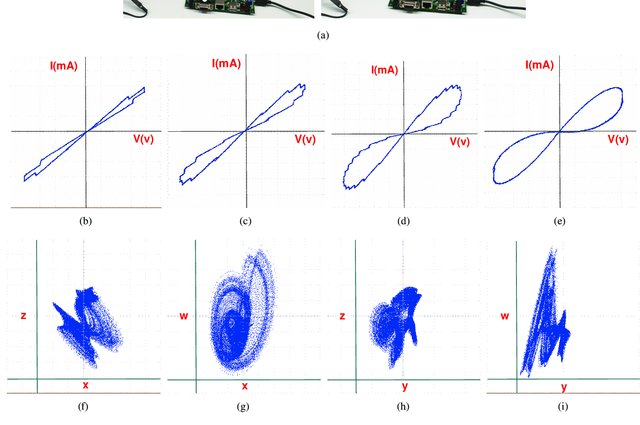
Digital Emulation of a Versatile Memristor with Speech Encryption Application
Memristor characteristics such as nonlinear dynamics, state retention and accumulation are useful for many applications. FPGA implementation of memristor-based systems and algorithms provides fast development and verification platform. In this work, we first propose a versatile digital memristor emulator that exhibits either continuous or discrete behaviors, similar to valence change memories (VCM) and the electrochemical metallization memories. Secondly, the proposed memristor emulator is used to design a chaotic generator circuit utilizing the memristor's nonlinearity. Finally, the chaotic
Fractional controllable multi-scroll V-shape attractor with parameters effect
This paper is an extension of V-shape multi-scroll butterfly attractor in the fractional-order domain. The system complexity is increased by the new dynamics introduced by the fractional operator which make it more suitable for random signal generator. The effect of system parameters on controlling the attractor shape is investigated and compared with the integer order attractor. Maximum Lyapunov exponent is calculated for both integer and fractional orders attractors to prove the complexity of fractional chaotic system using time series. © 2017 IEEE.
Fractional inverse generalized chaos synchronization between different dimensional systems
In this chapter, new control schemes to achieve inverse generalized synchronization (IGS) between fractional order chaotic (hyperchaotic) systems with different dimensions are presented. Specifically, given a fractional master system with dimension n and a fractional slave system with dimension m, the proposed approach enables each master system state to be synchronized with a functional relationship of slave system states. The method, based on the fractional Lyapunov approach and stability property of integer-order linear differential systems, presents some useful features: (i) it enables
Fractional inverse generalized chaos synchronization between different dimensional systems
In this chapter, new control schemes to achieve inverse generalized synchronization (IGS) between fractional order chaotic (hyperchaotic) systems with different dimensions are presented. Specifically, given a fractional master system with dimension n and a fractional slave system with dimension m, the proposed approach enables each master system state to be synchronized with a functional relationship of slave system states. The method, based on the fractional Lyapunov approach and stability property of integer-order linear differential systems, presents some useful features: (i) it enables
FPGA implementation of fractional-order Chua's chaotic system
This paper introduces FPGA implementation of fractional order double scrolls chaotic system based on Chua circuit. Grunwald-Letnikov's (GL) definition is used to generalize the chaotic system equations into the fractional-order domain. Xilinx ISE 14.5 is used to simulate the proposed design and Artix-7 XC7A100T FPGA is used for system realization. Experimental results are presented on digital oscilloscope and the error between theoretical and experimental results is calculated. Also, various interesting attractors are obtained with respect to different parameters values and window sizes. Some
Two topologies of fractional-order oscillators based on CFOA and RC networks
This paper presents two general topologies of fractional order oscillators. They employ Current Feedback Op-Amp (CFOA) and RC networks. Two RC networks are investigated for each presented topology. The general oscillation frequency, condition and the phase difference between the oscillatory outputs are investigated in terms of the fractional order parameters. Numerical simulations and P-Spice simulation results are provided for some cases to validate the theoretical findings. The fractional order parameters increase the design flexibility and controllability which is proved by the provided
Fractional-order inverting and non-inverting filters based on CFOA
This paper introduces a study to generalize the design of a continuous time filters into the fractional order domain. The study involves inverting and non-inverting filters based on CFOA where three responses are extracted which are high-pass, band-pass and low-pass responses. The proposed study introduces the generalized formulas for the transfer function of each response with different fractional orders. The fractional-order filters enhance the design flexibility and controllability due to the extra degree of freedom provided by the fractional order parameters. The general fundamentals of
CFOA-Based fractional order simulated inductor
In this paper, a generalized fractional-order form of the simulated inductor using a single current feedback operational amplifier (CFOA) and a fractional-order capacitor is introduced. Analytical expression of the equivalent fractionalorder inductor versus the circuit elements is achieved. Moreover, the effect of the parasitic impedance and the non-idealities of the CFOA are investigated analytically with numerical simulations and circuit equivalent. Circuit simulations are discussed using AD844 spice model to validate the theoretical study of the fractional-order inductor. Simulations show
Fractional Order Oscillator Design Based on Two-Port Network
In this paper, a general analysis of the generation for all possible fractional order oscillators based on two-port network is presented. Three different two-port network classifications are used with three external single impedances, where two are fractional order capacitors and a resistor. Three possible impedance combinations for each classification are investigated, which give nine possible oscillators. The characteristic equation, oscillation frequency and condition for each presented topology are derived in terms of the transmission matrix elements and the fractional order parameters α
Fractional-order oscillator based on single CCII
This paper presents a generalization of well-known phase shift oscillator based on single CCII into the fractional order domain. The general state matrix, characteristic equation and design equations are presented. The general oscillation frequency, condition and the phase difference between the oscillatory outputs are introduced in terms of the fractional order parameters. These parameters add extra degrees of freedom which in turn increase the design flexibility and controllability. Numerical discussion of five special cases is investigated including the integer case. Spice simulations and
Pagination
- Previous page ‹‹
- Page 32
- Next page ››
